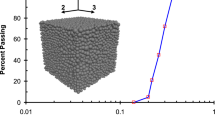Abstract
In a previous work, we developed a numerical model of compression by pressure solution (PS) of a single axisymmetric asperity pressed against a flat semi-infinite solid. The dissolution rate at any point along the contact and at any time t was determined by (1) computing the normal stress distribution from the current shape of the asperity, and (2) solving the diffusion equation inside the fluid-saturated solid-solid interface, including local dissolution source terms corresponding to the stress field previously determined. The change in shape of the asperity during an infinitesimal time interval δt can then be calculated and the entire procedure repeated as many times as desired. Our results showed that, as the contact flattens and grows during PS, the initial elastic deformation is partially relaxed and the stress transferred from the contact center to the edge. Our goal in the present paper is to demonstrate that, among a population of asperities, stress can also be transferred from one contact to another and that the overall compaction rate can be significantly affected by this process. For this purpose we extended our previous numerical model to simulate PS of two rigidly coupled spherical asperities simultaneously pressed against a flat semi-infinite solid. We considered two end-member cases: 1) transfer of stress to a newly created, not initially present contact, 2) transfer of stress between asperities with different sizes. In both cases, stress was transferred from the most stressed asperity to the least, and, the overall PS displacement rate was reduced. Thus, formation of new contacts and heterogeneous distribution of asperity sizes, which are both expected to exist in rough fractures with self-affine aperture or in heterogeneous granular materials with variable grain-packing geometry, may significantly slow down PS creep compaction.
Similar content being viewed by others
Author information
Authors and Affiliations
Rights and permissions
About this article
Cite this article
Bernabé, Y., Evans, B. & Fitzenz, D.D. Stress Transfer During Pressure Solution Compression of Rigidly Coupled Axisymmetric Asperities Pressed Against a Flat Semi-Infinite Solid. Pure appl. geophys. 166, 899–925 (2009). https://doi.org/10.1007/s00024-009-0477-2
Received:
Revised:
Accepted:
Published:
Issue Date:
DOI: https://doi.org/10.1007/s00024-009-0477-2




